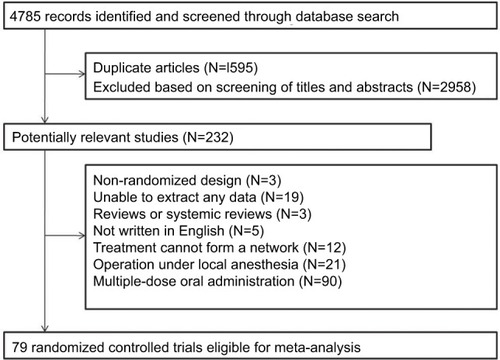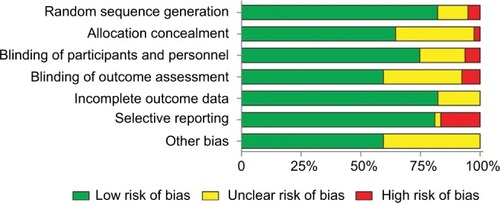Abstract
Background
Pregabalin (PGB) and gabapentin (GBP) are current and emerging drugs in the field of pre-emptive preoperative analgesia. However, the role of PGB or GBP in acute postoperative pain management still remains elusive.
Materials and methods
We conducted a comprehensive literature search of articles published by December 3, 2017. A total of 79 randomized controlled trials with 6,201 patients receiving single-dose premedication were included. Through a network meta-analysis (NMA), we validated the analgesic effect and incidence of adverse events by using various doses of PGB or GBP administration.
Results
NMA results suggested that the analgesic effect may be dose related. For 24-hour opioid consumption, a consistent decrease was found with the increase in the dose of PGB or GBP. For 24-hour pain score at rest, a high dose (≥150 mg) of PGB was more effective in decreasing pain score than a dose of 75 mg, and a high dose (≥900 mg) of GBP reduced pain intensity than doses of 300 or 600 mg. Moreover, the incidence of adverse reactions varied with varying doses of PGB or GBP.
Conclusion
A dose–response relationship was detected in opioid consumption and postoperative pain for a single-dose preoperative administration of PGB and GBP. Making reasonable choice of drugs and dosage may prevent the occurrence of adverse reactions.
Introduction
Acute postoperative pain associated with surgical wounds is commonly encountered in most patients after a surgical procedure.Citation1 Additionally, improper postoperative pain management is significantly related to higher risk of occurrence of severe complications to patients, such as delayed trauma recovery, pulmonary embolism, as well as myocardial ischemia.Citation2–Citation4
Since pre-emptive preoperative analgesia was first proposed by Wall in 1988, over the years it has been gradually regarded as an intervention given before incision, facilitating advance mobilization and functional rehabilitation after surgery.Citation5–Citation7 Preemptive analgesia focuses on reducing postoperative opioid consumption and pain levels, decreasing the incidence of adverse events and improving patient satisfaction. Several pre-emptive analgesic regimens have been tried in the perioperative period, including opioids, nonsteroidal anti-inflammatory drugs, and so on.Citation8,Citation9 Pregabalin (PGB) or gabapentin (GBP) is a current and emerging drug in this field. Although its use for the management of postoperative pain is off-label, its perioperative oral use has become widespread. So far, many meta-analyses have investigated the efficacy of perioperative PGB or GBP administration for preventing acute postoperative pain. However, the role of PGB or GBP in acute postoperative pain management still remains elusive. For instance, the study conducted by Jiang et alCitation10 showed that PGB appeared to be efficacious in providing relief from postoperative pain, reducing analgesic consumption, and lowering the risk of nausea following spine surgery. Nevertheless, Eipe et alCitation11 demonstrated that the analgesic effectiveness of PGB was significantly limited to surgery associated with pronociceptive mechanisms. Additionally, previous studies were largely restricted to specific doses or methods of perioperative PGB or GBP administration.Citation10,Citation11 Consequently, in the present study, we aim to compare the analgesic effect and incidence of adverse events by administering different doses of PGB or GBP before surgery, and we expect to provide more insights into the optimal dose and drug selection of preemptive analgesics.
Materials and methods
Strategy and criteria of search
The following databases were searched: PubMed, Embase, and the Cochrane Library with the last update by December 3, 2017. The corresponding search term combinations were (“pregabalin” or “gabapentin”) AND (“pain” or “analgesia”) AND (“random*”). After excluding duplicate studies, we screened eligible studies manually by reviewing the titles, abstracts, and full papers.
Inclusion criteria: randomized clinical trials were included if they satisfied the following selection criteria: 1) premedication with single dose of PGB or GBP; 2) acute postoperative pain; and 3) operation under intravertebral anesthesia or general anesthesia.
Exclusion criteria: 1) multiple-dose oral administration of PGB and GBP (long-term preoperative administration or postoperative administration); 2) chronic postoperative pain; 3) operation under local anesthesia; 4) unable to extract any data; and 5) not published in English or Chinese.
Outcomes
Eight groups were set up by the dose treatments of PGB and GBP: placebo (PBO), PGB 75 mg, PGB 150 mg, PGB 300 mg, GBP 300 mg, GBP 600 mg, GBP 900 mg, and GBP 1,200 mg.
Primary outcomes (analgesic effect): 1) opioid consumption, 2) pain score at rest (visual analog scale or numeric rating scale score), and 3) pain score at movement. (All data were recorded within 24 hours after surgery.)
Secondary outcomes (adverse events): 1) PONV (postoperative nausea and vomiting within 24 hours after surgery); 2) nausea; 3) vomiting; and 4) dizziness.
Data extraction
The corresponding data were independently extracted from the selected studies by two independent investigators, and any controversies were resolved through consultation with the third reviewer. The following data were acquired from qualified studies and performed in Supplemental Digital Content: first author, published year, sample size, sex, type of surgery and anesthesia, PGB or GBP administration time, and clinical outcomes. The Cochrane Collaboration’s Risk of Bias Tool was used for randomized controlled trials to estimate the quality assessment of the included study.Citation12
Statistical analysis
A network meta-analysis (NMA) was conducted by integrating both direct and indirect evidence by using STATA software (version 14.0). We used PBO as a reference treatment in all analyses. Additionally, standardized mean difference (SMD) was used to estimate the outcomes (pain score at rest, pain score at movement, and opioid consumption) of the different doses of PGB and GBP. Moreover, OR was used to describe the outcomes of PONV, nausea, vomiting, and dizziness. Surface under the cumulative ranking curve (SUCRA) was conducted to represent the corresponding ranking of each outcome, and the higher the SUCRA values, the more preferable the intervention. After that, the assessment of the degree of inconsistency between direct and indirect evidence in each loop was conducted by using the node-splitting method. Also, risk of publication bias was indicated by funnel plots. Through sensitivity analyses, we considered opioid consumption as the most objective outcome, which was the most reported and had the largest heterogeneity variance. Our sensitivity analyses consisted of excluding studies that reported median instead of mean. The mean estimate was equal to the median, while SD approximates the quartile range, divided by 1.35 or the range divided by 4.
Results
Description of included studies
As illustrates, 4,785 records were retrieved from the PubMed, Embase, and Cochrane Library in the initial literature search. After exclusion of duplicate articles and screening of titles and abstracts, 232 citations remained for further analysis. Finally, 79 randomized controlled trials with 6,201 patients were subject to full-text review.Citation13–Citation91 These studies were performed from 2002 to 2017 in 23 countries. Patients included in the studies underwent various types of surgeries: obstetrics and gynecology surgery (22.8%), spinal surgery (10.1%), orthopedic joint surgery (17.7%), urology surgery (7.6%), visceral surgery (16.4%), cardiac surgery (3.8%), and others (20.3%). Additionally, 62 studies (78.5%) used general anesthesia and the others (21.5%) used spinal anesthesia. The administration time varied between these studies: (29.1%) ≤1 hour before surgery, (41.8%) >1 hour before surgery, (17.7%) ≤1 hour before anesthesia, and (10.1%) >1 hour before anesthesia. One study did not provide details of the administration time (Table S1). The network of eligible comparisons is presented in . In addition, 62 studies were two-arm trials (two of them were based on comparison between PGB and GBP), 13 were three-arm trials (three test samples were involved: PGB, GBP, and PBO), two were four-arm trials, and one was five-arm trial.
Figure 2 Network plots of eligible comparisons of all interventions including PBO, PGB 75 mg, PGB 150 mg, PGB 300 mg, GBP 300 mg, GBP 600 mg, GBP 900 mg, and GBP 1,200 mg.
Abbreviations: GBP, gabapentin; PBO, placebo; PGB, pregabalin; PONV, postoperative nausea and vomiting within 24 hours after surgery.
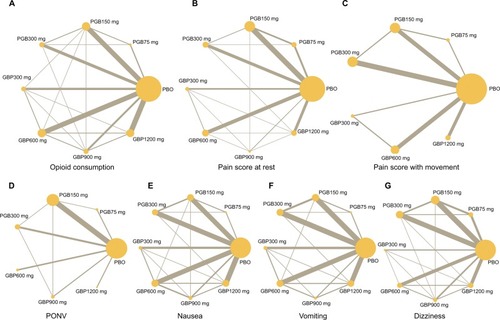
Primary outcomes (analgesic effect)
Fifty-two studies, including a total of 3,827 patients, reported data for postoperative opioid consumption. All interventions consumed less opioids than PBO, and administration of increasing dose of PGB or GBP significantly decreased the consumption of opioids (). The following results were obtained: PGB 150 mg vs PBO: SMD −1.66, 95% CI −2.28 to −1.03; PGB 300 mg vs PBO: SMD −1.86, 95% CI −2.68 to −1.03; GBP 300 mg vs PBO: SMD −0.98, 95% CI −1.86 to −0.10); GBP 600 mg vs PBO: SMD −1.14, 95% CI −1.77 to −0.50; GBP 900 mg vs PBO: SMD −1.64, 95% CI −2.60 to −0.67; GBP 1,200 mg vs PBO: SMD −1.86, 95% CI −2.51 to −1.21. No significant differences were found between the PGB 75 mg and control groups (PGB 75 mg vs PBO: SMD −0.18, 95% CI −1.46 to 1.09). SUCRA curve graph is shown in . The four largest SUCRA values for postoperative opioid consumption were as follows: GBP 1,200 mg (81.1), PGB 300 mg (80.1), PGB 150 mg (70.9), and GBP 900 mg (69.4).
Figure 3 Forest plots of all interventions.
Abbreviations: GBP, gabapentin; PBO, placebo; PGB, pregabalin; SMD, standardized mean difference.
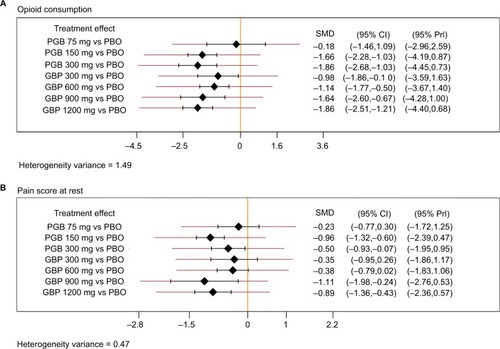
Figure 4 Ranking of SUCRA values.
Abbreviations: GBP, gabapentin; PBO, placebo; PGB, pregabalin; SUCRA, surface under the cumulative ranking curve.
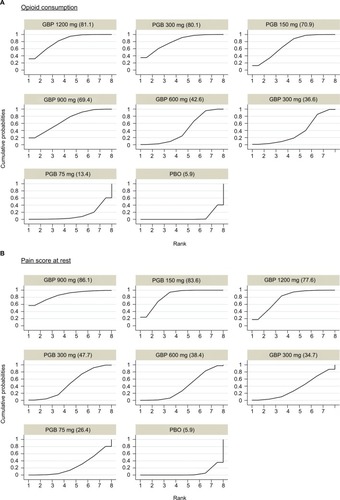
Forty-eight studies, including a total of 3,664 patients, reported data for pain score at rest. Patients with PGB (150/300 mg) and GBP (900/1,200 mg) exhibited significantly less pain compared with those with PBO (). The results were as follows: PGB 150 mg vs PBO: SMD −0.96, 95% CI −1.32 to −0.60; PGB 300 mg vs PBO: SMD −0.50, 95% CI −0.93 to −0.07; GBP 900 mg vs PBO: SMD −1.11, 95% CI −1.98 to −0.24; GBP 1,200 mg vs PBO: SMD −0.89, 95% CI −1.36 to −0.43, and no significant differences were found between patients taking others doses and PBO. The three largest SUCRA values for pain score at rest were as follows: GBP 900 mg (86.1), PGB 150 mg (83.6), and GBP 1,200 mg (77.6) ().
Fifteen studies, including a total of 1,215 patients, reported data for pain score at movement. No significant differences were found between any of the interventions and control groups. Only the SUCRA values of GBP 1,200 mg (78.3) and PGB 150 mg (68.0) were larger than PBO (50.9) ().
Table 1 SUCRA value and effect size in comparison to PBO
Secondary outcomes (adverse events)
Overall, PGB 300 mg reduced the incidence of PONV (PGB 300 mg vs PBO: OR 0.18, 95% CI 0.09, 0.37) and nausea (PGB 300 mg vs PBO: OR 0.50, 95% CI 0.35, 0.72) compared with the control groups. In addition, patients with GBP 1,200 mg showed higher incidence of PONV (GBP 1,200 mg vs PBO: OR 5.21, 95% CI 1.48, 18.34). However, incidence of dizziness increased when PGB 150 mg or PGB 300 mg was used (PGB 150 mg vs PBO: OR 1.94, 95% CI 1.10, 3.42; PGB 300 mg vs PBO: OR 2.49, 95% CI 1.46, 4.23). No significant differences were found between the interventions and control groups for incidence of vomiting (). Complete forest plots of summary effects are displayed in Figure S1.
Risk of bias assessment
The risk of bias assessment is presented in as well as in Table S2. The most common high risk of bias was selective reporting (16.5%), which principally resulted from the consideration of incomplete outcome data. As illustrated in Figure S2, no risk of publication bias was found for any outcomes. A contribution plot showed the risk of bias of each direct or indirect comparison, which is shown in Figure S3.
Sensitivity analyses
We conducted sensitivity analyses for opioid consumption by excluding studies only reporting median instead of mean (n=8). SUCRA ranking for overall treatment was not markedly affected: PGB 300 mg (83.6), GBP 1,200 mg (82.4), GBP 900 mg (63.6.), PGB 150 mg (61.2), PGB 75 mg (42.8), GBP 600 mg (34.8), GBP 300 mg (29.1), and PBO (2.5). Heterogeneity variance was 1.19 (Figure S4).
Inconsistency
Node-splitting method was used to assess inconsistency in the analysis. Only a few loops had inconsistent results for each outcome (Figure S5).
Discussion
Pre-emptive analgesia given before incision focuses on managing postoperative pain including decreasing the consumption of analgesics as well as conferring neuroprotective characteristics.Citation9 Although many meta-analyses have investigated the analgesic efficacy of perioperative PGB or GBP administration so far, the role of PGB or GBP in acute postoperative pain management still remains elusive. Moreover, few studies compared different doses of abovementioned drugs for preventing acute postoperative pain.
Recently, the study performed by Fabritius et alCitation92 demonstrated that they could not confirm a distinct relationship between the dose of GBP and the consumption of opioids, dividing all treatments into subgroups despite single or multiple doses, preoperative or postoperative administrations. In the present study, we presented an NMA to validate the effect of analgesic and risk of adverse events by a series of doses of PGB or GBP administration. Interestingly, our results indicated that a dose–response relationship was detected in analgesic effect of preoperative PGB or GBP treatment. For 24-hour opioid consumption, as an objective marker for measurements of pain relief in postoperative studies, a consistent decrease was found with the increase in the dose of GBP or PGB. For 24-hour pain score at rest, a high dose (≥150 mg) of PGB was more effective in decreasing pain score than dose of 75 mg, and a high dose (≥900 mg) of GBP reduced pain intensity than doses of 300 or 600 mg.
Recent paper suggested that PGB and GBP may share a similar mechanism in the treatment and prevention of postoperative pain, affecting one type of calcium channel to decrease the release of some neurotransmitters such as noradrenaline.Citation93–Citation95 Additionally, a nonlinear process of satu-rable absorption exists in orally administered GBP, making its plasma concentrations less predictable. In contrast, total bioavailability of PGB remains at more than 90% regardless of dose.Citation96,Citation97 A trial displayed by Ifuku et alCitation98 suggested that effectiveness of PGB on neuropathic pain was six times that of GBP.
Previous studies have disclosed that unalleviated postoperative pain was associated with various complications such as deep veins thrombosis, increased heart rate, and blood pressure.Citation88,Citation95 Our analysis also indicated that preoperative single-dose administration of PGB or GBP would influence the incidence of postoperative adverse reactions. Previously, Kohli et alCitation88 reported that the reduction of postoperative blood pressure, heart rate, as well as anxiety level was significantly related to preoperative single-dose administration of PGB. In the current study, of note, using a high dose (≥300 mg) of PGB preoperatively is one of the approaches to prevent PONV and nausea, but not vomiting. The underlying mechanism of preventing PONV and nausea by PGB may be as follows: 1) nausea and vomiting are one of the side effects of opioids; pre-emptive analgesia using PGB may reduce preoperative and intraoperative opioid requirements, thereby resulting in decreased incidence of PONV and nausea. 2) The reduction in tachykinin neurotransmission, calcium influx, as well as inflammatory response at the surgical site may explain the underlying mechanisms of anti-emetic properties of PGB.Citation99,Citation100
A previous meta-analysis which investigated nausea and vomiting as the primary outcomes (44 studies, n=3,489) found that GBP is associated with a reduction in postoperative nausea and vomiting.Citation101 However, there was no significant difference between control groups and GBP in our NMA. Recent findings have established that pharmacokinetic properties vary by PGB and GBP, which might be one of the reasons for the difference in our study. Orally administered GBP achieved maximum plasma concentrations within 3–4 hours, while PGB is absorbed more rapidly and attained the maximum plasma concentrations within 1 hour.Citation96 In addition, since we did not search for adverse effects alone in the database, the results in our study may be incomplete.
Highlights
Our NMA is the first dose-related NMA of the impact of PGB and GBP on acute postoperative pain, revealing that a suitable single dose of preoperative PGB or GBP administration has a significant effect in reducing opioid consumption and postoperative pain. In addition, our study comprehensively analyzed the analgesic effect combined with incidence of adverse events. The results suggested that a high dose (≥150 mg) of PGB can increase the rate of dizziness, and a high dose (≥300 mg) of PGB decreases the incidence of PONV and nausea, while GBP 1,200 mg increases the rate of PONV.
Limitations
First, the heterogeneity of opioid consumption could not be absolutely explained. In the current study, sensitivity analysis based on the type of data was focused on explaining it, but the analgesic effect of PGB or GBP may be confounded by patient characteristic, ethnic status, timing of administration, type of surgery, or intraoperative medication. Therefore, further data analysis is essential to avoid these interference factors. Second, we only included end points about opioid consumption and pain score with follow-up at 24 hours postoperatively. Third, the relatively small sample size of the certain included studies may have affected the accuracy of the effect size estimation.
Conclusion
The results of our current study demonstrated that a dose– response relationship was detected in opioid consumption and postoperative pain for a single-dose preoperative administration of PGB and GBP. Making reasonable choice of drugs and dosage may prevent the occurrence of adverse reactions. Future clinical trials are required to determine the differences in analgesic effect between single-dose oral administration and multiple-dose oral administration. Furthermore, the optimal doses of these medications and timing of administration of pre-emptive analgesia still require further study, which may help make the standardization and rationalization of multimodal analgesia possible.
Acknowledgments
The project was supported by the Natural Science Foundation of Zhejiang Province (LY16H290003 to Juan Zhang).
Disclosure
The authors report no conflicts of interest in this work.
References
- American Society of Anesthesiologists Task Force on Acute Pain ManagementPractice guidelines for acute pain management in the perioperative setting: an updated report by the American Society of Anesthesiologists Task Force on Acute Pain ManagementAnesthesiology200410061573158115166580
- MisiołekHCettlerMWorońJWordliczekJDobrogowskiJMayzner-ZawadzkaEThe 2014 guidelines for post-operative pain managementAnaesthesiol Intensive Ther201446422124425293474
- KissinIPreemptive analgesiaAnesthesiology20009341138114311020772
- ParsonsBSchaeferCMannREconomic and humanistic burden of post-trauma and post-surgical neuropathic pain among adults in the United StatesJ Pain Res2013645946923825931
- KatzJMccartneyCJCurrent status of preemptive analgesiaCurr Opin Anaesthesiol200215443544117019235
- VadiveluNMitraSSchermerEKodumudiVKayeADUrmanRDPreventive analgesia for postoperative pain control: a broader conceptLocal Reg Anesth20147172224872720
- WallPDThe prevention of postoperative painPain19883332892903419835
- Lavand’hommePDe KockMWaterloosHIntraoperative Epidural Analgesia Combined with Ketamine Provides Effective Preventive Analgesia in Patients Undergoing Major Digestive SurgeryAnesthesiology2005103481382016192774
- GottschalkAUpdate on preemptive analgesiaTech Reg Anesth Pain Manag200373116121
- JiangHLHuangSSongJWangXCaoZSPreoperative use of pregabalin for acute pain in spine surgery: A meta-analysis of randomized controlled trialsMedicine (Baltimore)20179611e612928296725
- EipeNPenningJYazdiFPerioperative use of pregabalin for acute pain-a systematic review and meta-analysisPain201515671284130025830925
- HigginsJPTGreenSCochrane Handbook for Systematic Reviews of Interventions Version 5.1.0LondonThe Cochrane Collaboration2011 Available from http://handbook.cochrane.org
- PandeyCKKarnaSTTandonMPandeyVKSinghAComparative evaluation of prophylactic use of pregabalin, gabapentin and diclofenac sodium for prevention of succinylcholine-induced myalgia: a randomized, double-blinded studyJ Postgrad Med2014601162024625934
- Mardani-KiviMKarimi MobarakehMKeyhaniSHaghighiMHashemi-MotlaghKSaheb-EkhtiariKArthroscopic bankart surgery: Does gabapentin reduce postoperative pain and opioid consumption? A triple-blinded randomized clinical trialOrthop Traumatol Surg Res2016102554955327178738
- DirksJFredensborgBBChristensenDFomsgaardJSFlygerHDahlJBA Randomized Study of the Effects of Single-dose Gabapentin versus Placebo on Postoperative Pain and Morphine Consumption after MastectomyAnesthesiology200297356056412218520
- KochharAChouhanKPanjiarPVajifdarHGabapentinoids as a Part of Multi-modal Drug Regime for Pain Relief following Laproscopic Cholecystectomy: A Randomized StudyAnesth Essays Res201711367668028928570
- SyalKGomaMDograRKOhriAGuptaAKGoelA“Protective Premedication”: A Comparative Study of Acetaminophen, Gabapentin and Combination of Acetaminophen with Gabapentin for Post-Operative AnalgesiaJ Anaesth Clin Pharmacol2010264531536
- PandeyCKPriyeSSinghSSinghUSinghRBSinghPKPreemptive use of gabapentin significantly decreases postoperative pain and rescue analgesic requirements in laparoscopic cholecystectomyCan J Anaesth200451435836315064265
- Al-MujadiHA-RefaiARKatzarovMGDehrabNABatraYKAl-QattanARPreemptive gabapentin reduces postoperative pain and opioid demand following thyroid surgeryCan J Anaesth200653326827316527792
- MontazeriKKashefiPHonarmandAPre-emptive gabapentin significantly reduces postoperative pain and morphine demand following lower extremity orthopaedic surgerySingapore Med J200748874875117657384
- Mardani-KiviMMobarakehMKKeyhaniSMotlaghKHEkhtiariKSIs gabapentin effective on pain management after arthroscopic anterior cruciate ligament reconstruction? A triple blinded randomized controlled trialArch Bone Jt Surg201311182225207278
- PandeyCKSinghalVKumarMGabapentin provides effective postoperative analgesia whether administered pre-emptively or post-incisionCan J Anaesth200552882783116189334
- HuotM-PChouinardPGirardFRuelMLafontaineERFerraroPGabapentin does not reduce post-thoracotomy shoulder pain: a randomized, double-blind placebo-controlled studyCan J Anesth200855633734318566196
- PandeyCKNavkarDVGiriPJEvaluation of the optimal preemptive dose of gabapentin for postoperative pain relief after lumbar diskectomy: a randomized, double-blind, placebo-controlled studyJ Neurosurg Anesthesiol2005172656815840990
- DenizMNSertozNErhanEUgurGEffects of preoperative gabapentin on postoperative pain after radical retropubic prostatectomyJ Int Med Res20124062362236923321194
- BangSRYuSKKimTHCan gabapentin help reduce postoperative pain in arthroscopic rotator cuff repair? A prospective, randomized, double-blind studyArthroscopy2010269 SupplS106S11120810085
- BartholdyJHilstedKLHjortsoeNCEngbaekJDahlJBEffect of Gabapentin on morphine demand and pain after laparoscopic sterilization using Filshie clips. A double blind randomized clinical trialBMC Anesthesiol20066111217083725
- BroglyNWattierJMAndrieuGGabapentin attenuates late but not early postoperative pain after thyroidectomy with superficial cervical plexus blockAnesth Analg200810751720172518931238
- DurmusMButAKSaricicekVToprakHIErsoyMOThe postoperative analgesic effects of a combination of gabapentin and paracetamol in patients undergoing abdominal hysterectomy: a ran-domized clinical trialActa Anaesthesiol Scand200751329930417257177
- TuranAKaramanlioğluBMemis¸DAnalgesic effects of gabapentin after spinal surgeryAnesthesiology2004100493593815087630
- KarbićVOŠkodaMAntončićDGabapentin-induced changes of plasma cortisol level and immune status in hysterectomized womenInt Immunopharmacol201423253053625448495
- KhademiSGhaffarpasandFHeiranHRAsefiAEffects of preoperative gabapentin on postoperative nausea and vomiting after open cholecystectomy: a prospective randomized double-blind placebo-controlled studyMed Princ Pract2010191576019996621
- KhanZHRahimiMMakaremJKhanRHOptimal dose of pre-incision/post-incision gabapentin for pain relief following lumbar laminectomy: a randomized studyActa Anaesthesiol Scand201155330631221288211
- MayellASrinivasanICampbellFPeliowskiAAnalgesic effects of gabapentin after scoliosis surgery in children: a randomized controlled trialPaediatr Anaesth201424121239124425230144
- MendaFKönerOSayınMErgenoğluMKüçükaksuSAykaçBEffects of single-dose gabapentin on postoperative pain and morphine consumption after cardiac surgeryJ Cardiothorac Vasc Anesth201024580881320056448
- MénigauxCAdamFGuignardBSesslerDIChauvinMPreoperative gabapentin decreases anxiety and improves early functional recovery from knee surgeryAnesth Analgesia2005100513941399
- RimazSAlaviCESedighinejadATolouieMKavoosiSKoochakinejadLEffect of gabapentin on morphine consumption and pain after surgical debridement of burn wounds: a double-blind randomized clinical trial studyArch Trauma Res201211384324719841
- RorariusMGMennanderSSuominenPGabapentin for the prevention of postoperative pain after vaginal hysterectomyPain2004110117518115275765
- SandersJGCameronCDawesPJDGabapentin in the Management of Pain following Tonsillectomy: A Randomized Double-Blind Placebo-Controlled TrialOtolaryngol Head Neck Surg2017157578179028741425
- SenHSizlanAYanaratesOA comparison of gabapentin and ketamine in acute and chronic pain after hysterectomyAnesth Analg200910951645165019843803
- SiddiquiNTFischerHGuerinaLFriedmanZEffect of a preoperative gabapentin on postoperative analgesia in patients with inflammatory bowel disease following major bowel surgery: a randomized, placebo-controlled trialPain Pract201414213213923560500
- TuranAKaramanlioğluBMemis¸DUsarPPamukçuZTüreMThe analgesic effects of gabapentin after total abdominal hysterectomyAnesth Analg20049851370137315105217
- AjoriLNazariLMazloomfardMMAmiriZEffects of gabapentin on postoperative pain, nausea and vomiting after abdominal hysterectomy: a double blind randomized clinical trialArch Gynecol Obstet2012285367768221818576
- MohammadiSSSeyediMEffects of gabapentin on early postoperative pain, nausea and vomiting in laparoscopic surgery for assisted reproductive technologiesPak J Biol Sci200811141878188018817237
- SrivastavaUKumarASaxenaSMishraARSaraswatNMishraSEffect of preoperative gabapentin on postoperative pain and tramadol consumption after minilap open cholecystectomy: a randomized double-blind, placebo-controlled trialEur J Anaesthesiol201027433133519935070
- BhartiNBalaINarayanVSinghGEffect of gabapentin pretreatment on propofol consumption, hemodynamic variables, and postoperative pain relief in breast cancer surgeryActa Anaesthesiol Taiwan2013511101323711599
- ShortJDowneyKBernsteinPShahVCarvalhoJCA single preoperative dose of gabapentin does not improve postcesarean delivery pain management: a randomized, double-blind, placebo-controlled dose-finding trialAnesth Analg201211561336134223011560
- TomarGSSinghFCherianGRole of Preemptive Gabapentin on Postoperative Analgesia After Infraumbilical Surgeries Under Sub-arachnoid Block-A Randomized, Placebo-Controlled, Double-Blind StudyAm J Ther201711
- KinneyMAMantillaCBCarnsPEPreoperative gabapentin for acute post-thoracotomy analgesia: a randomized, double-blinded, active placebo-controlled studyPain Pract201212317518321676165
- HamalPKShresthaABShresthaRREfficacy of Preemptive Gabapentin for Lower Extremity Orthopedic surgery under Subarachnoid BlockJNMA J Nepal Med Assoc20155320021021327746457
- Panah KhahiMYaghootiAAMarashiSHNadjafiAEffect of preemptive gabapentin on postoperative pain following lower extremity orthopaedic surgery under spinal anaesthesiaSingapore Med J2011521287988222159930
- ClarkeHPereiraSKennedyDAdding gabapentin to a multimodal regimen does not reduce acute pain, opioid consumption or chronic pain after total hip arthroplastyActa Anaesthesiol Scand20095381073108319572933
- IttichaikultholWVirankabutraTKunopartMKhamhomWPutarawuthichaiPRungphetSEffects of pregabalin on post operative morphine consumption and pain after abdominal hysterectomy with/without salphingo-oophorectomy: a randomized, double-blind trialJ Med Assoc Thai200992101318132319845240
- HegartyDAShortenGDA Randomised, Placebo-controlled Trial of the Effects of Preoperative Pregabalin on Pain Intensity and Opioid Consumption following Lumbar DiscectomyKorean J Pain2011241223021390175
- GhaiAHoodaSWadheraRGuptaMSinglaDA randomized controlled trial to compare pregabalin with gabapentin for postoperative pain in abdominal hysterectomySaudi J Anaesth20115325225721957402
- FujitaNTobeMTsukamotoNSaitoSObataHA randomized placebo-controlled study of preoperative pregabalin for postoperative analgesia in patients with spinal surgeryJ Clin Anesth20163114915327185699
- BalabanFYağarSÖAKoçMGüllapoğluHA randomized, placebo-controlled study of pregabalin for postoperative pain intensity after laparoscopic cholecystectomyJ Clin Anesth201224317517822459341
- AydoğanHKucukAYuceHHAdding 75 mg pregabalin to analgesic regimen reduces pain scores and opioid consumption in adults following percutaneous nephrolithotomyRev Bras Anestesiol201464533534225168438
- Cabrera SchulmeyerMCde la MazaJOvalleCFariasCVivesIAnalgesic effects of a single preoperative dose of pregabalin after laparoscopic sleeve gastrectomyObes Surg201020121678168119727980
- AhnSByunSHParkKHaJLKwonBKimJCAnalgesic efficacy of preemptive pregabalin administration in arthroscopic shoulder surgery: a randomized controlled trialCan J Anaesth201663328328926475164
- HettaDFMohamedMAMohammadMFAnalgesic efficacy of pregabalin in acute postmastectomy pain: placebo controlled dose ranging studyJ Clin Anesth20163430330927687397
- MishraRTripathiMChandolaHCComparative clinical study of gabapentin and pregabalin for postoperative analgesia in laparoscopic cholecystectomyAnesth Essays Res201610220120627212747
- EsmatIMFaragHMComparative study between paracetamol and two different doses of pregabalin on postoperative pain in laparoscopic cholecystectomySaudi J Anaesth20159437638026543452
- SprengUJDahlVRaederJEffect of a single dose of pregabalin on post-operative pain and pre-operative anxiety in patients undergoing discectomyActa Anaesthesiol Scand201155557157621385158
- LeeCLeeHWKimJNEffect of oral pregabalin on opioid-induced hyperalgesia in patients undergoing laparo-endoscopic single-site urologic surgeryKorean J Anesthesiol2013641192423372881
- DemirhanATekeliogluUYAkkayaAEffect of pregabalin and dexamethasone addition to multimodal analgesia on postoperative analgesia following rhinoplasty surgeryAesthetic Plast Surg20133761100110624057811
- DemirhanAAkkayaATekeliogluUYEffect of pregabalin and dexamethasone on postoperative analgesia after septoplastyPain Res Treat20142014285079424876957
- AhiskaliogluAInceI˙AksoyMYalcinEAhiskaliogluEOKilincAEffects of a Single-Dose of Pre-Emptive Pregabalin on Postoperative Pain and Opioid Consumption After Double-Jaw Surgery: A Randomized Controlled TrialJ Oral Maxillofac Surg201674153.e1726433040
- EidyMFazelMRAbdolrahimzadehHMoravvejiARKochakiEMohammadzadehMEffects of pregabalin and gabapentin on postoperative pain and opioid consumption after laparoscopic cholecystectomyKorean J Anesthesiol201770443443828794839
- AlimianMImaniFHassaniVRahimzadehPSharifianMSafariSEffects of Single-Dose Pregabalin on Postoperative Pain in Dacryocystorhinostomy SurgeryAnesth Pain Med201222727624223341
- SagitMYalcinSPolatHKorkmazFCetinkayaSSomdasMAEfficacy of a single preoperative dose of pregabalin for postoperative pain after septoplastyJ Craniofac Surg201324237337523524696
- AgarwalAGautamSGuptaDAgarwalSSinghPKSinghUEvaluation of a single preoperative dose of pregabalin for attenuation of postoperative pain after laparoscopic cholecystectomyBr J Anaesth2008101570070418716003
- MathiesenOJørgensenDGHilstedKLPregabalin and dexa-methasone improves post-operative pain treatment after tonsillectomyActa Anaesthesiol Scand201155329730521288210
- MathiesenORasmussenMLDierkingGPregabalin and dexamethasone in combination with paracetamol for postoperative pain control after abdominal hysterectomy. A randomized clinical trialActa Anaesthesiol Scand200953222723519076108
- BouziaATassoudisVKaranikolasMPregabalin Effect on Acute and Chronic Pain after Cardiac SurgeryAnesthesiol Res Pract201720171275396228539936
- KumarKPKulkarniDKGurajalaIGopinathRPregabalin versus tramadol for postoperative pain management in patients undergoing lumbar laminectomy: a randomized, double-blinded, placebo-controlled studyJ Pain Res20136647147823837006
- ZiyaeifardMMehrabanianMJFaritusSZPremedication with oral pregabalin for the prevention of acute postsurgical pain in coronary artery bypass surgeryAnesth Pain Med201551e2483725830118
- Bornemann-CimentiHLedererAJWejboraMPreoperative pregabalin administration significantly reduces postoperative opioid consumption and mechanical hyperalgesia after transperitoneal nephrectomyBr J Anaesth2012108584584922362672
- MartinezVCymermanABen AmmarSThe analgesic efficiency of combined pregabalin and ketamine for total hip arthroplasty: a randomised, double-blind, controlled studyAnaesthesia2014691465224320856
- WhitePFTufanogullariBTaylorJKleinKThe effect of pregabalin on preoperative anxiety and sedation levels: a dose-ranging studyAnesth Analg200910841140114519299776
- PrasadABhattacharyyaSBiswasASahaMMondalSSahaDA comparative study of pre-operative oral clonidine and pregabalin on post-operative analgesia after spinal anesthesiaAnesth Essays Res201481414725886102
- BafnaURajarajeshwaranKKhandelwalMVermaAPA comparison of effect of preemptive use of oral gabapentin and pregabalin for acute post-operative pain after surgery under spinal anesthesiaJ Anaesthesiol Clin Pharmacol201430337337725190946
- KiatchaiTSanansilpVTriyasunantNSaengprateepSChangkittiratPAchariyapotaVEffects of pregabalin on postoperative pain after hysterectomy under spinal anesthesia with intrathecal morphine: a randomized controlled trialJ Anesth201731686186828918556
- RajappaGCVigSBevanaguddaiahYAnadaswamyTCEfficacy of Pregabalin as Premedication for Post-Operative Analgesia in Vaginal HysterectomyAnesth Pain Med201663e3459127642577
- El KenanySEl TahanMREffect of preoperative pregabalin on post-caesarean delivery analgesia: a dose-response studyInt J Obstet Anesth201626243126718698
- SebastianBTalikotiATNelamangalaKKrishnamurthyDEffect of Oral Pregabalin as Preemptive Analgesic in Patients Undergoing Lower Limb Orthopedic Surgeries under Spinal AnaesthesiaJ Clin Diagn Res2016107UC01UC04
- KhetarpalRKatariaAPBajajSKaurHSinghSGabapentin vs pregabalin as a premedication in lower limb orthopaedics surgery under combined spinal epidural techniqueAnesth Essays Res201610226226727212758
- KohliMMuraliTGuptaRKhanPBograJOptimization of Subarachanoid Block by Oral Pregabalin for HysterectomyJ Anaesth Clin Pharmacol2011271101105
- MathiesenOJacobsenLSHolmHEPregabalin and dexamethasone for postoperative pain control: a randomized controlled study in hip arthroplastyBr J Anaesth2008101453554118653493
- MihyePYounghoonJPreoperative pregabalin prolongs duration of spinal anesthesia and reduces early postoperative pain: A double-blind, randomized clinical CONSORT studyMedicine (Baltimore)20169536e482827603398
- AkhavanakbariGEntezariaslMIsazadehfarKMirzarahimiTThe effects of oral pregabalin on post-operative pain of lower limb orthopedic surgery: A double-blind, placebo-controlled trialPerspect Clin Res20134316516824010057
- FabritiusMLWetterslevJMathiesenODahlJBDose-related beneficial and harmful effects of gabapentin in postoperative pain management - post hoc analyses from a systematic review with meta-analyses and trial sequential analysesJ Pain Res2017102547256329138592
- TaylorCPMechanisms of analgesia by gabapentin and pregabalin-calcium channel alpha2-delta [Cavalpha2-delta] ligandsPain20091421–2131619128880
- DauriMFariaSGattiACelidonioLCarpenedoRSabatoAFGabapentin and pregabalin for the acute post-operative pain management. A systematic-narrative review of the recent clinical evidencesCurrent Drug Targets200910871673319702520
- DahlJBMathiesenOMøinicheSProtective premedication’: an option with gabapentin and related drugs?Acta Anaesthesiol Scand201048911301136
- BockbraderHNWescheDMillerRChapelSJaniczekNBurgerPA comparison of the pharmacokinetics and pharmacodynamics of pregabalin and gabapentinClin Pharmacokinet2010491066166920818832
- GajrajNMPregabalin: its pharmacology and use in pain managementAnesth Analg200710561805181518042886
- IfukuMIsekiMHidakaIMoritaYKomatusSInadaEReplacement of Gabapentin with Pregabalin in Postherpetic Neuralgia TherapyPain Med20111271112111621692969
- FinkKDooleyDJMederWPInhibition of neuronal Ca(2+) influx by gabapentin and pregabalin in the human neocortexNeuropharmacology200242222923611804619
- FehrenbacherJCTaylorCPVaskoMRPregabalin and gabapentin reduce release of substance P and CGRP from rat spinal tissues only after inflammation or activation of protein kinase CPain20031051–213314114499429
- GrantMCBetzMHulseMThe Effect of Preoperative Pregabalin on Postoperative Nausea and Vomiting: A Meta-analysisAnesth Analg201612351100110727464972

